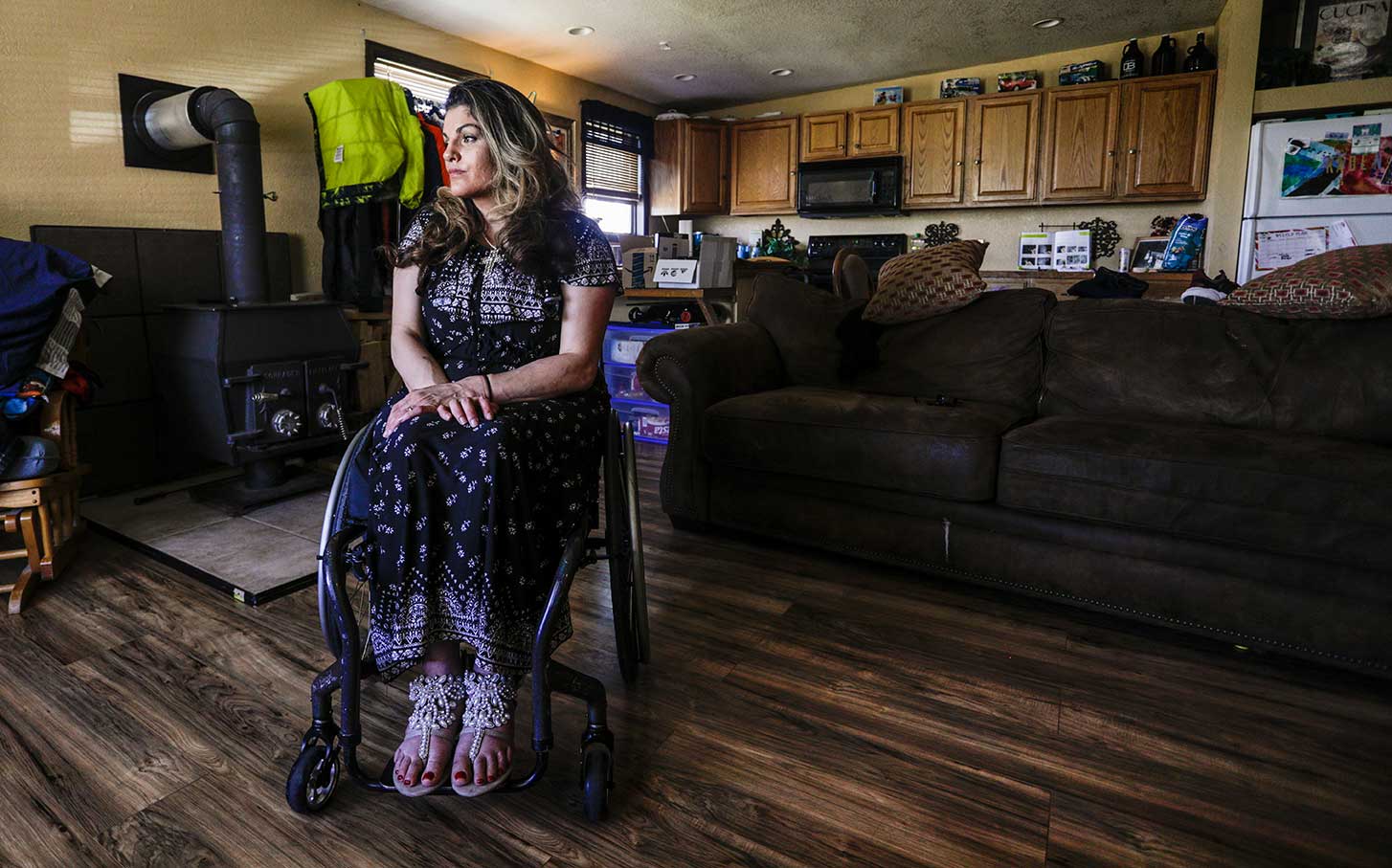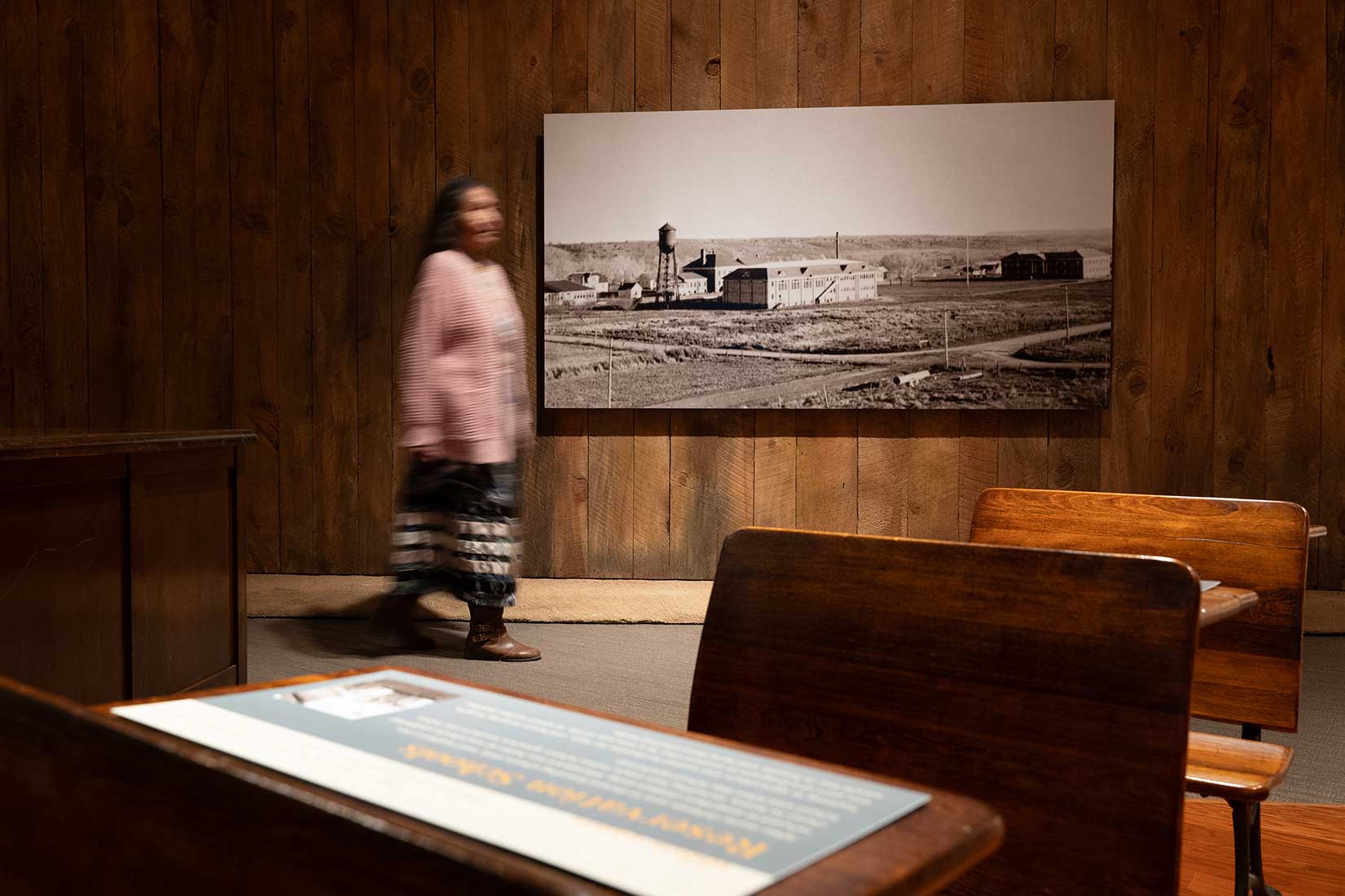Rachel Frey gets frequent reminders that she’s hit the literal end of the road in her search for affordable housing.
It happens every time her wheelchair grinds against the dirt of the county road near Calhan, miles outside of her preferred home base of Colorado Springs. A $1,000/month apartment in Calhan is all she can afford on disability income, and even then she needs a paying roommate in the second bedroom—the bedroom that should go to her 12-year-old son—since her income support is only $771 a month.
So Frey, a 34-year-old single mother whose vehicle was smashed by a garbage truck on Interstate 25 last year, bunks in with her son. And when her 16-year-old son visits on weekends, it’s one big slumber party by necessity.
“It’s sad,” said Frey, who is energetic and always trying to move forward, but realistic about the crushing realities of affordable, accessible housing for people with disabilities. “What can you do? I’m hoping to try out for Miss Wheelchair Colorado, but I can barely meet my phone bill and the rent.”
Affordable housing challenges for people like Frey are systematically detailed statewide for the first time in a new report by the Colorado Health Institute (CHI), commissioned by a cohort of 18 nonprofits working together to advocate for more equitable policies and practices in the state. The group of nonprofits receives funding through The Colorado Trust’s Health Equity Advocacy strategy.
Coloradans are increasingly focused on secure housing as a crucial social determinant of health, at the same time as the affordability issue—from the mountains to the plains, and from the top of the Front Range metro areas to the bottom—has rocketed to the forefront of policy debates. The organizations making up the cohort had plenty of anecdotal evidence about Colorado’s affordability crisis in housing, but contracted with CHI to take a systems-level look that could drive local and statewide policy change.
“The link the report makes between housing and health is something that people intuitively know, but didn’t have the data or terminology to speak to,” said Stephanie Perez-Carillo, a policy analyst with the Colorado Children’s Campaign, one of advocacy nonprofits in the group.
Many of the resulting data points are startling: Fewer than 1 percent of homes in the country are accessible to wheelchairs. Sixty percent of Coloradans feel their communities are in a housing crisis. Nearly half of Colorado renters are cost-burdened, meaning they spend more than 30 percent of their income on housing and sometimes have to choose between rent, health care costs, utilities, food or other essentials. And the percentage of cost-burdened families among Colorado communities of color is far higher than among white residents.
Of the non-coastal states, Colorado ranks second after only Nevada for its percentage of residents who are cost-burdened in housing. Colorado home prices increased 77 percent at the median from 2008 to 2018; in the same 10 years, median income rose less than 5 percent.
The cohort asked CHI to focus on seven specific populations as part of its research, many of which have a combination of higher risk factors and baked-in historical disadvantages in seeking affordable housing:
- Communities of color
- Low-income communities
- Families with children
- Rural communities
- People experiencing homelessness
- People living with disabilities
- Anyone lacking immigration documentation.
Already encountering the challenges outlined in at least two of CHI’s focus categories—living with disability and a low income—Rachel Frey’s family has teetered on the edge of another: homelessness.
The search for accessible and affordable housing becomes all-consuming for renters who use wheelchairs, Frey said. As she continued her long recovery from the physical toll of the highway crash, she saw doors closing in all directions. She learned that at her age, she hadn’t worked enough fiscal quarters to qualify for full disability, limiting her check to $771 a month.
She looked into federal Section 8 housing vouchers, which can pay much of the rent for those who qualify. Yet in Colorado Springs, voucher applications for the year are available on only one day in July; if she made it through the lottery, the wait list is already 1,700 deep, and administrators estimated it would be a three-year wait.
None of that addresses the physical condition of apartments and homes she looked at. With less than one percent of private housing accessible to wheelchairs, Frey had to seek housing that could be readily adapted with temporary ramps. She started sending able-bodied friends to look at listings and take videos to show her later, after finding that landlords were usually scared off by her wheelchair.
Countless times, Frey bumped into violations of accessibility laws and clear intent to exclude disabled applicants who were perceived as bringing high adaptive costs and other problems. But Frey was too busy on other fronts to take the time to formally protest: she needed personal care for a wound, and was told she might have to separate from her son to get nursing home care.
For now, the Calhan place is barely affordable. It does allow access to home health aides who still visit frequently. “I’m on dirt roads out here, so I can’t take my wheelchair out anywhere,” Frey said. When her boys are around, they can help push through the county roads, or drive her to accessible hikes she still loves to do.
She is frustrated there are so few housing opportunities for people with significant disabilities, and is determined to become a more high-profile advocate on the issue. No one that is disabled “should be told from her doctor, ‘Go live in a nursing home since there is nowhere else for you to go,’” Frey said.
For more remote areas like Leadville, the CHI report documents multiple housing challenges, spanning the categories of rural and low-income housing, and racial and documentation issues.
Noah Sosin and Eudelia Contreras work on housing affordability issues for Lake County Build a Generation, a nonprofit that is part of the cohort. They were among the many member organizations that pushed for a housing study because of what they confront every day.
A previous Lake County housing coalition assessment of housing needs found many shelter options literally locked out of reach of most residents, Sosin said—at any given time in Lake County, an estimated 29% of the homes sit vacant (up from 24% in 2000) because they are someone’s little-used vacation home or are held out for short-term rentals.
The organization also found a startling drop in the 25- to 35-year-old population—the group best-suited to build families and futures in the county—with many respondents citing housing costs. The housing stock was static and mismatched to needs, with 72% single-family homes, 16% manufactured homes, and very few apartments or duplexes.
At the time of the housing assessment in Lake County, only three available units could be identified among rental complexes in Leadville.
Manufactured homes—the mobile homes or simple units that can be placed on rented plots—are one of the few reliable options in Lake County, but have their own volatility, Contreras said. Her own space in a manufactured home community rented for $250 a month 15 years ago, but now goes for $530.
“And there’s no control over what the owners do with it long-term,” Contreras added. “It’s zoned commercial, so they wouldn’t even need a public hearing to rezone” and develop it into something else.
The group of nonprofits wanted CHI researchers to link current housing inequality with historical, systemic policy decisions and institutional practices that created or worsened the problems. For example, extensive research has proven that urban segregation, lower rates of homeownership for people of color, and lower-performing neighborhood schools are linked to historic “redlining” practices by governments and banks, refusing to issue mortgages beyond the boundaries of favored, whiter neighborhoods.
Today, “reverse redlining” is prevalent, said Emily Johnson, CHI’s policy and analysis director, with financial institutions targeting neighborhoods of color with high-cost, high-risk subprime mortgages and predatory high-interest payday lending. It was important that the CHI study “not just blame it on the past,” Johnson said.
Linking the current challenges to past policy decisions also opened the way for the report to recommend future policy changes that could alleviate housing costs. The cohort of nonprofits focused on “low-hanging fruit” for policy change in 11 practical and actionable areas, Johnson said.
Leadville advocates want to support growth and ownership stability in manufactured housing, which they say is often an overlooked and affordable option in rural counties. Developers and architects, meanwhile, have been perfecting new designs in manufactured housing that appeal to a broader range of consumers and offer more family amenities.
There is interest in Lake County for resident ownership of manufactured housing zones, and for potential public/community ownership, both of which would head off the threat of national real estate developers buying Leadville-area mobile parks and closing them or raising rents.
Building the resident capacity for that kind of advocacy work is the first challenge, Sosin said. Leadville has long been a cheaper bedroom community for resort workers commuting to jobs in Aspen, Vail or Summit County; as many as 75 percent of job-holding residents work outside Lake County, according to the local housing assessment. Some of those are Mexican-American immigrants.
“There are folks here without documented legal status, and in any environment it’s hard to ask people to find their voice and put themselves on the line, but even more so when we really can’t guarantee any safety or protection,” Sosin said. “The landlords really do hold all the power, and even if there are nominal protections against retaliation, there are really few functional protections.”
Policy ideas outlined in the cohort’s housing study that could improve access for people with disabilities include expansion of medical-legal partnerships, where dedicated lawyers team with medical professionals to help patients navigate tangles in housing, benefits and other needs; and allowing health workers to be certified as building inspectors to insure safety and quality of housing.
The group of advocates believe their efforts have already contributed to success in policy changes, including at the 2019 state legislative session that saw approval of a cluster of long-sought pro-tenant policies. They believe the granular, statewide CHI report—which included input from regions such as Lake County, northwestern Colorado and the San Luis Valley—will further strengthen the urban-rural coalition for one of their next big policy goals: passage of so-called income anti-discrimination rules for rental housing. That legal change would bar landlords from refusing Section 8 housing vouchers, which some owners see as bureaucratic and unpredictable.
“The coalition for 2020 will only be stronger,” Perez-Carillo said, “and also more representative, not only of Denver, but also the rural communities that may not get as much of the opportunity to give their voice.”




